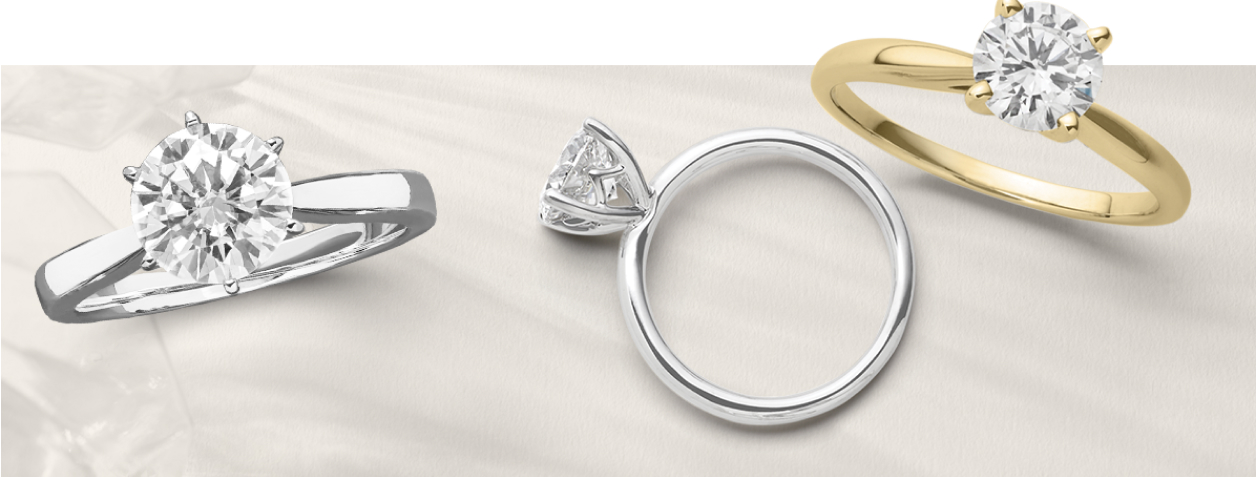
From Round to Princess: Evaluating Diamond Shapes and Their Trade-offs
When selecting a diamond, the shape is a critical factor that influences both aesthetics and value. Each diamond shape possesses unique characteristics that can affect the brilliance, perceived size, and overall appeal of the stone. In this comprehensive guide, we will explore the pros and cons of various diamond shapes, providing you with detailed insights to make an informed decision.
Table of Contents
ToggleRound Brilliant Cut
Pros
- Maximized Brilliance: The round brilliant cut is renowned for its unparalleled sparkle due to its 58 facets, which are meticulously arranged to reflect light optimally.
- Versatile Design: This shape suits a wide range of settings, from solitaire to intricate halo designs, making it a timeless choice.
- Symmetry and Balance: The round shape offers perfect symmetry, enhancing its overall visual appeal and balance.
- Market Demand: High popularity ensures easy availability and a strong resale value.
Cons
- Higher Cost: The round brilliant cut often comes at a premium due to higher demand and greater rough diamond wastage during cutting.
- Commonality: Its popularity means it is less unique, diamonds shapes pros and cons, which may not appeal to those seeking a distinctive style.
Princess Cut
Pros
- Modern Aesthetic: With its sharp, square or rectangular shape and brilliant faceting, the princess cut offers a contemporary look.
- Exceptional Fire: The princess cut exhibits remarkable fire and brilliance, second only to the round brilliant cut.
- Efficient Use of Rough: This cut utilizes more of the rough diamond, potentially offering better value for carat weight.
Cons
- Prone to Chipping: The sharp corners can be more vulnerable to damage if not properly protected the setting.
- Depth Requirement: A deeper cut can result in a smaller face-up appearance compared to other shapes of the same carat weight.
Emerald Cut
Pros
- Elegant Appearance: The emerald cut’s long lines and step cuts exude a sophisticated and vintage charm.
- Large Surface Area: Its broad, flat surface showcases the diamond’s clarity and size more prominently.
- Unique Look: Less common than other cuts, it offers a distinctive and refined aesthetic.
Cons
- Lower Brilliance: Step cuts emphasize clarity and luster over brilliance, resulting in less sparkle compared to brilliant cuts.
- Visible Inclusions: The large, open facets make inclusions and color more noticeable, requiring higher clarity grades.
Cushion Cut
Pros
- Antique Appeal: With its rounded corners and larger facets, the cushion cut combines vintage charm with contemporary appeal.
- Exceptional Fire: The cut’s larger facets enhance its fire, producing a captivating play of light.
- Versatile Design: Works well with a variety of settings, from classic to modern.
Cons
- Depth Retention: Similar to the princess cut, a deeper cut can make the diamond appear smaller than its carat weight suggests.
- Color Retention: This cut tends to retain color more, making higher color grades desirable.
Oval Cut
Pros
- Elongating Effect: The oval shape can make the wearer’s fingers appear longer and more slender.
- Brilliant Sparkle: Similar to the round cut, the oval cut offers excellent brilliance and fire.
- Larger Appearance: The elongated shape provides a larger face-up appearance, maximizing perceived size.
Cons
- Bow-Tie Effect: Many oval cuts display a dark bow-tie effect across the center, which can be distracting if too prominent.
- Symmetry Challenges: Perfect symmetry is crucial for a balanced look, making it essential to choose a well-proportioned diamond.
Marquise Cut
Pros
- Maximized Carat Weight: The elongated shape makes the diamond appear larger, offering more bang for your buck.
- Regal Look: Its distinctive shape exudes elegance and sophistication, often associated with royalty.
- Finger-Flattering: The marquise cut can enhance the appearance of slender, elongated fingers.
Cons
- Pronounced Bow-Tie: Like the oval cut, the marquise cut can exhibit a noticeable bow-tie effect.
- Fragile Points: The pointed ends require protective settings to prevent chipping and damage.
Pear Cut
Pros
- Unique Shape: Combining the brilliance of a round cut with the elongation of a marquise, the pear cut offers a unique and elegant look.
- Versatile Orientation: Can be worn with the point facing up or down, lab made diamonds, providing versatility in style.
- Elongating Effect: The shape can make fingers appear longer and more graceful.
Cons
- Bow-Tie Effect: Like other elongated cuts, the pear shape can exhibit a bow-tie effect.
- Challenging Symmetry: Perfect symmetry is essential to avoid a lopsided appearance, making selection crucial.
Asscher Cut
Pros
- Vintage Charm: The Asscher cut’s step cuts and square shape with clipped corners offer a distinctive Art Deco appeal.
- Clarity Emphasis: Its large, open facets highlight the diamond’s clarity, providing a mesmerizing luster.
- Sophisticated Style: Less common than other cuts, it offers a unique and sophisticated appearance.
Cons
- Lower Brilliance: Similar to the emerald cut, the Asscher cut prioritizes clarity and luster over brilliance, resulting in less sparkle.
- Visible Inclusions: Inclusions and color are more noticeable, requiring higher clarity grades for the best appearance.
Radiant Cut
Pros
- Hybrid Brilliance: Combines the rectangular shape of an emerald cut with the brilliant faceting of a round cut, offering a unique blend of sparkle and shape.
- Versatile Setting: Works well with a variety of settings, enhancing its adaptability.
- Durability: The cropped corners make it less prone to chipping compared to square cuts with sharp corners.
Cons
- Depth and Size: A deeper cut can reduce the apparent size of the diamond, similar to other deep cuts.
- Color Emphasis: Can retain more color, making higher color grades preferable.
Heart Cut
Pros
- Romantic Symbolism: The heart shape is a classic symbol of love and romance, making it a meaningful choice for engagement rings.
- Distinctive Look: Offers a unique and eye-catching appearance that stands out.
- Brilliant Faceting: Similar to the round cut, it provides excellent sparkle and brilliance.
Cons
- Challenging Symmetry: Perfect symmetry is essential for a balanced look, making selection crucial.
- Less Popular: Its unique shape is less common, which may affect resale value and availability.
In conclusion, choosing the right diamond shape involves considering the pros and cons of each option to match your personal style, preferences, and practical needs. By understanding the unique characteristics and trade-offs of each shape, you can select a diamond that not only meets your aesthetic desires but also offers the best value and longevity. Whether you prioritize brilliance, size, or uniqueness, there is a diamond shape that perfectly complements your vision.
Related Posts

Forever in Style: Timeless Wedding Jewelry for Brides

Bridal Glow, Diamond Shine – Perfect for Bridal Jewelry: Radiant Elegance

